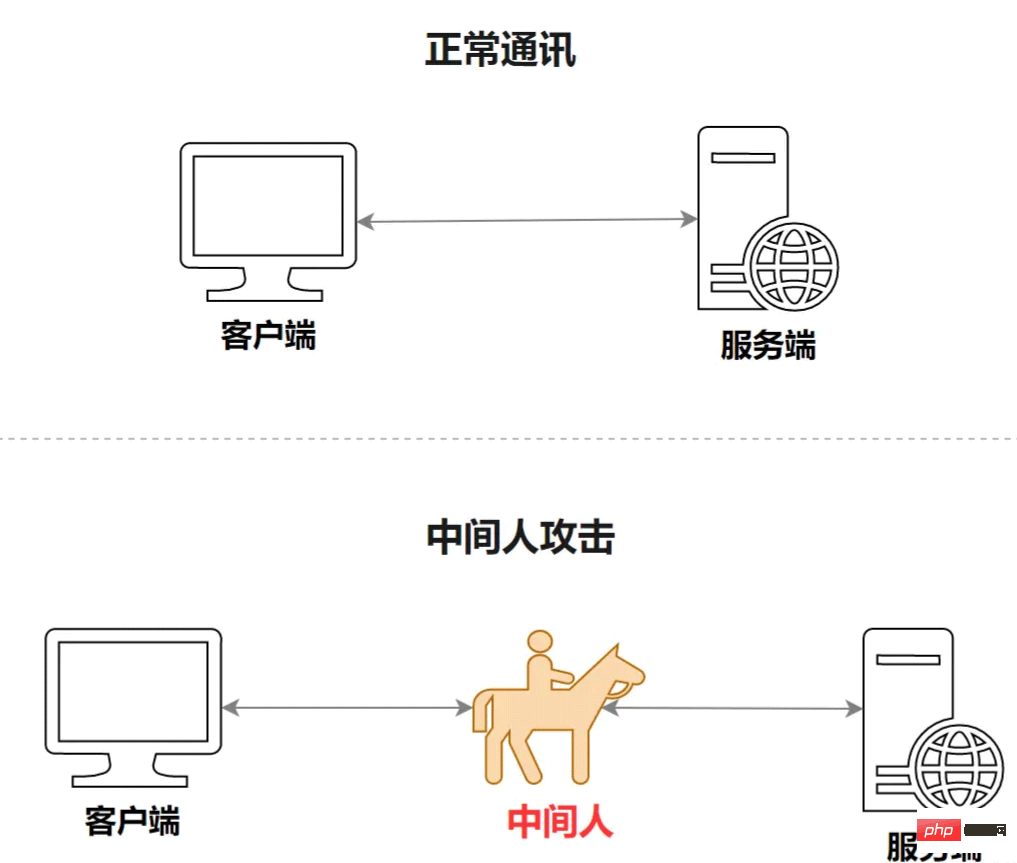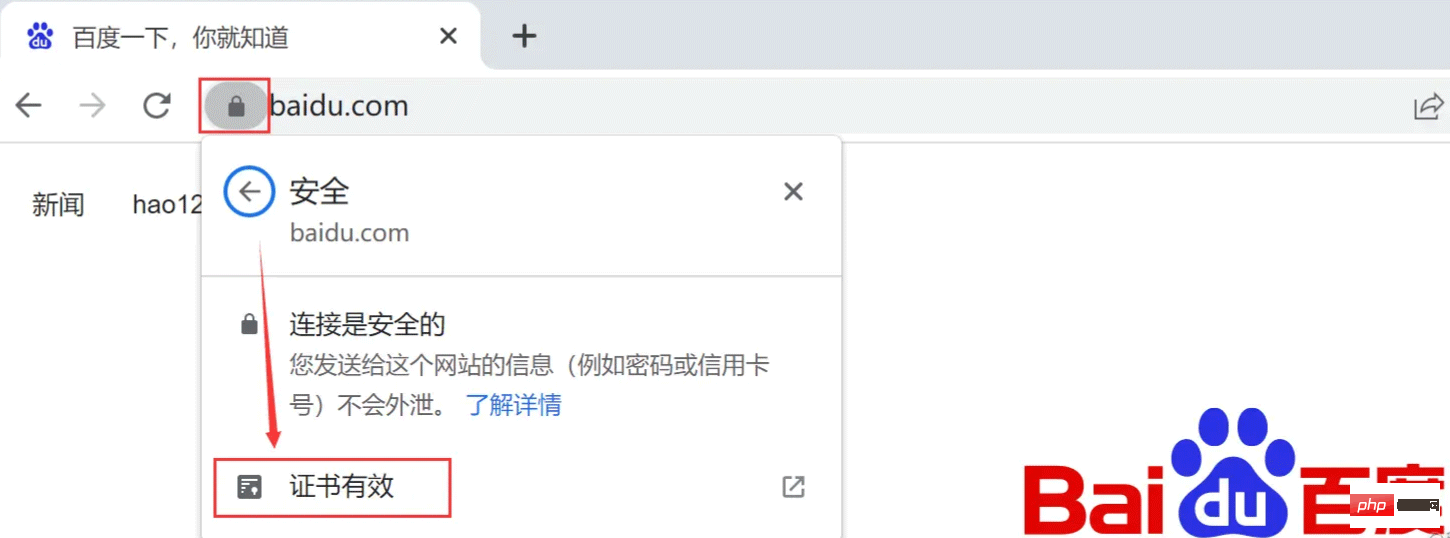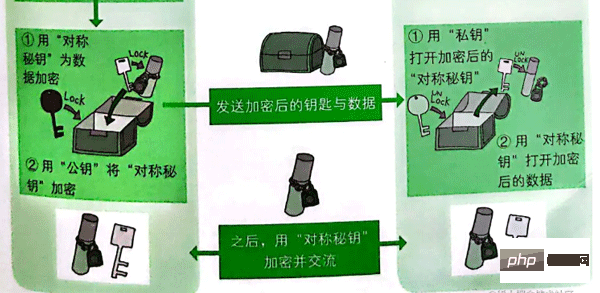What are the reasons and advantages of using HTTPS in Java?
1.HTTP
Before talking about HTTPS, we must first understand HTTP, because HTTP is the basis of HTTPS communication. HTTP (HyperText Transport Protocol) Hypertext Transfer Protocol, which is used to transmit client-side and server-side data.
HTTP is very simple and convenient to use, but it has the following three fatal problems:
Using clear text communication, the content can be eavesdropped.
If the true identity of the communicating party is not verified, the person may be disguised.
The integrity of the message cannot be proven and it is easily tampered with.
In view of the above problems, the current system will use HTTPS instead of HTTP.
2.HTTPS
First of all, HTTPS is not a new protocol, but adds an encryption mechanism SSL (Secure Socket Layer) or TLS (Transport) based on the HTTP protocol. Layer Security). HTTPS = HTTP encryption, authentication and integrity protection.
SSL and TLS:
SSL (Secure Socket Layer) was first developed by browser developer Netscape, which developed SSL 3.0 and versions before 3.0, and then SSL was handed over to the Internet Engineering Task Force (IETF). The IETF developed TLS 1.0 based on SSL 3.0, so TLS can be considered a "new version" of SSL.
2.1 Solve the trust problem
As for HTTPS, the first thing to solve is the trust problem, that is, the problem of identity verification. If the trust problem is not solved, there will be server camouflage, that is, " Man-in-the-middle attack" problem. The so-called man-in-the-middle attack means that under normal circumstances, the client and server should interact directly, but here a "bad guy" (man-in-the-middle) emerges, which is included between the client and server for Stealing and tampering with the communication content between the two parties,
is shown in the figure below:

HTTPS uses digital certificates to solve the trust problem The solution is that when the server is first created, it will first apply for a reliable digital certificate from a third-party platform recognized by everyone, and then when the client accesses (server), the server will first give the client a number Certificate to prove that you are a reliable server and not a "middleman". At this time, the browser will be responsible for validating and checking the validity of the digital certificate. If there is a problem with the digital certificate, the client will stop communication immediately. If there is no problem, the subsequent process will be executed.
As shown below Shown:

With the digital certificate, you can verify the true identity of the server. This solves the problem of "man-in-the-middle attack" and also solves the problem. The problem of disguise.
2.2 Solve the problem of clear text transmission and integrity
Although we have solved the trust problem above, because the two parties communicate in clear text, there is still a risk of the communication content being eavesdropped during communication. , what should we do at this time? So we thought of using encryption to solve the problem of information exposure.
Classification of encryption
Encryption is mainly divided into two categories: Symmetric encryption and asymmetric encryption.
In symmetric encryption, there is a shared secret key. Through this shared secret key, information encryption and information decryption can be achieved. It is characterized by fast encryption and decryption speeds. , but due to the problem of shared secret keys, once the shared secret keys are intercepted, the so-called encryption and decoding are empty talk.
In asymmetric encryption, there is a pair of secret keys: a public key and a private key. The public key can be used to encrypt information, but it cannot be decrypted. The private key can be used to decrypt information. Its characteristic is that the server saves the private key and does not expose it to the outside world. It only sends the public key to the client. Even if others get the public key, they cannot decrypt the encrypted information. Therefore, this method is more secure, but asymmetric encryption The execution speed is relatively slow.
So should we use symmetric encryption or asymmetric encryption in HTTPS? Use symmetric encryption, which is fast but insecure; use asymmetric encryption, which is secure but slow. Only children make the choice, adults do, so HTTPS uses both asymmetric encryption and symmetric encryption. Its entire interaction process is like this:


The HTTPS execution process is as follows:
The client uses HTTPS to access the server.
The server returns a digital certificate and uses asymmetric encryption to generate a public key to the client (the server keeps the private key itself).
The client verifies whether the digital certificate is valid. If it is invalid, the access is terminated. If valid:
Use symmetric encryption to generate a shared secret key;
Use symmetric encryption shared secret key to encrypt data;
Use asymmetric encryption public key encryption (generated by symmetric encryption) shared secret key.
Send the encrypted secret key and data to the server.
The server uses the private key to decrypt the client's shared secret key (generated using symmetric encryption), and then uses the shared secret key to decrypt the specific content of the data.
After that, the client and server interact using the content encrypted by the shared secret key.
In this way, HTTPS not only ensures security but also ensures efficiency, which can be said to have the best of both worlds.
Using encryption also indirectly ensures the integrity of the data. If there is incomplete data or redundant data, an error will be reported during decryption, thus indirectly ensuring the data. of completeness.
The above is the detailed content of What are the reasons and advantages of using HTTPS in Java?. For more information, please follow other related articles on the PHP Chinese website!

Hot AI Tools

Undresser.AI Undress
AI-powered app for creating realistic nude photos

AI Clothes Remover
Online AI tool for removing clothes from photos.

Undress AI Tool
Undress images for free

Clothoff.io
AI clothes remover

Video Face Swap
Swap faces in any video effortlessly with our completely free AI face swap tool!

Hot Article

Hot Tools

Notepad++7.3.1
Easy-to-use and free code editor

SublimeText3 Chinese version
Chinese version, very easy to use

Zend Studio 13.0.1
Powerful PHP integrated development environment

Dreamweaver CS6
Visual web development tools

SublimeText3 Mac version
God-level code editing software (SublimeText3)

Hot Topics
 Java Spring Interview Questions
Aug 30, 2024 pm 04:29 PM
Java Spring Interview Questions
Aug 30, 2024 pm 04:29 PM
In this article, we have kept the most asked Java Spring Interview Questions with their detailed answers. So that you can crack the interview.
 Break or return from Java 8 stream forEach?
Feb 07, 2025 pm 12:09 PM
Break or return from Java 8 stream forEach?
Feb 07, 2025 pm 12:09 PM
Java 8 introduces the Stream API, providing a powerful and expressive way to process data collections. However, a common question when using Stream is: How to break or return from a forEach operation? Traditional loops allow for early interruption or return, but Stream's forEach method does not directly support this method. This article will explain the reasons and explore alternative methods for implementing premature termination in Stream processing systems. Further reading: Java Stream API improvements Understand Stream forEach The forEach method is a terminal operation that performs one operation on each element in the Stream. Its design intention is
 TimeStamp to Date in Java
Aug 30, 2024 pm 04:28 PM
TimeStamp to Date in Java
Aug 30, 2024 pm 04:28 PM
Guide to TimeStamp to Date in Java. Here we also discuss the introduction and how to convert timestamp to date in java along with examples.
 Java Program to Find the Volume of Capsule
Feb 07, 2025 am 11:37 AM
Java Program to Find the Volume of Capsule
Feb 07, 2025 am 11:37 AM
Capsules are three-dimensional geometric figures, composed of a cylinder and a hemisphere at both ends. The volume of the capsule can be calculated by adding the volume of the cylinder and the volume of the hemisphere at both ends. This tutorial will discuss how to calculate the volume of a given capsule in Java using different methods. Capsule volume formula The formula for capsule volume is as follows: Capsule volume = Cylindrical volume Volume Two hemisphere volume in, r: The radius of the hemisphere. h: The height of the cylinder (excluding the hemisphere). Example 1 enter Radius = 5 units Height = 10 units Output Volume = 1570.8 cubic units explain Calculate volume using formula: Volume = π × r2 × h (4
 PHP vs. Python: Understanding the Differences
Apr 11, 2025 am 12:15 AM
PHP vs. Python: Understanding the Differences
Apr 11, 2025 am 12:15 AM
PHP and Python each have their own advantages, and the choice should be based on project requirements. 1.PHP is suitable for web development, with simple syntax and high execution efficiency. 2. Python is suitable for data science and machine learning, with concise syntax and rich libraries.
 PHP: A Key Language for Web Development
Apr 13, 2025 am 12:08 AM
PHP: A Key Language for Web Development
Apr 13, 2025 am 12:08 AM
PHP is a scripting language widely used on the server side, especially suitable for web development. 1.PHP can embed HTML, process HTTP requests and responses, and supports a variety of databases. 2.PHP is used to generate dynamic web content, process form data, access databases, etc., with strong community support and open source resources. 3. PHP is an interpreted language, and the execution process includes lexical analysis, grammatical analysis, compilation and execution. 4.PHP can be combined with MySQL for advanced applications such as user registration systems. 5. When debugging PHP, you can use functions such as error_reporting() and var_dump(). 6. Optimize PHP code to use caching mechanisms, optimize database queries and use built-in functions. 7
 Create the Future: Java Programming for Absolute Beginners
Oct 13, 2024 pm 01:32 PM
Create the Future: Java Programming for Absolute Beginners
Oct 13, 2024 pm 01:32 PM
Java is a popular programming language that can be learned by both beginners and experienced developers. This tutorial starts with basic concepts and progresses through advanced topics. After installing the Java Development Kit, you can practice programming by creating a simple "Hello, World!" program. After you understand the code, use the command prompt to compile and run the program, and "Hello, World!" will be output on the console. Learning Java starts your programming journey, and as your mastery deepens, you can create more complex applications.
 How to Run Your First Spring Boot Application in Spring Tool Suite?
Feb 07, 2025 pm 12:11 PM
How to Run Your First Spring Boot Application in Spring Tool Suite?
Feb 07, 2025 pm 12:11 PM
Spring Boot simplifies the creation of robust, scalable, and production-ready Java applications, revolutionizing Java development. Its "convention over configuration" approach, inherent to the Spring ecosystem, minimizes manual setup, allo






